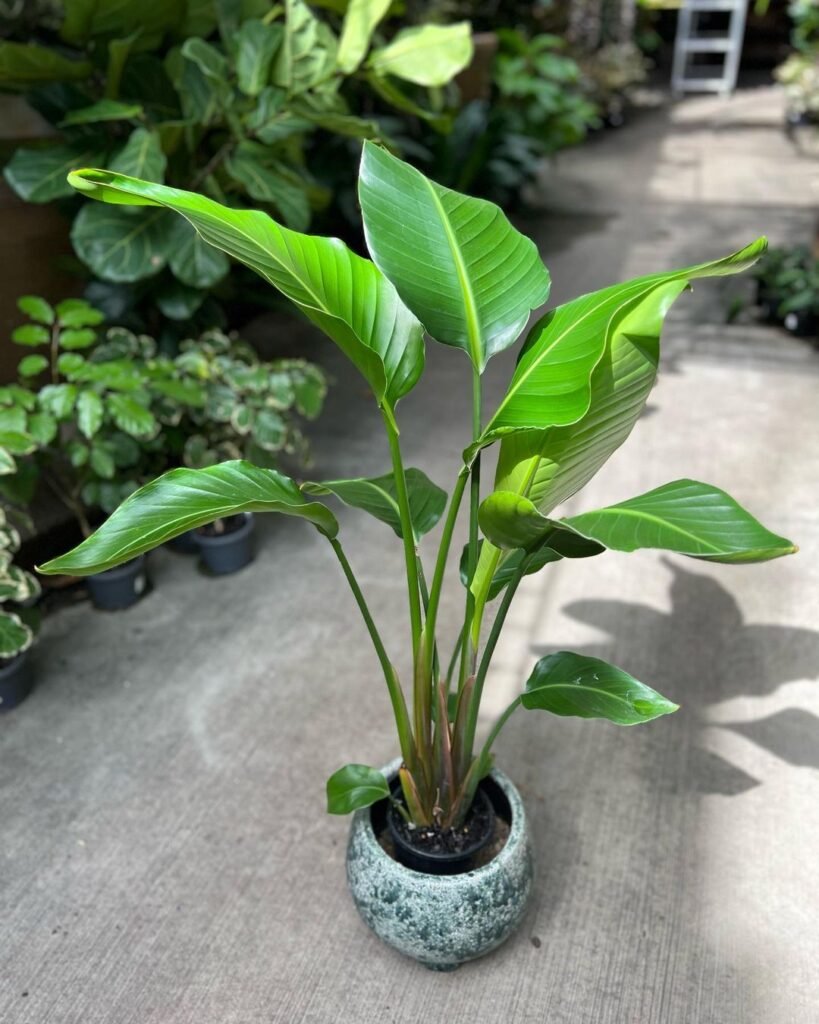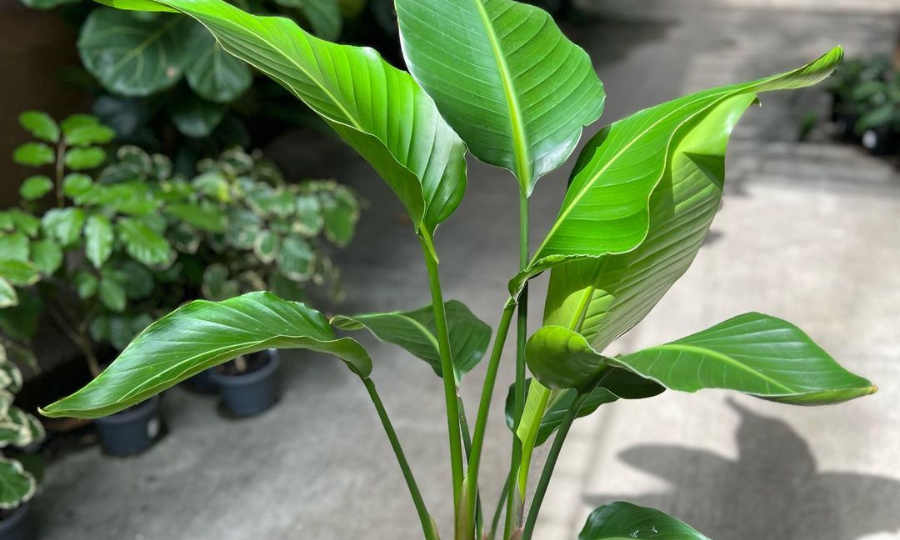Learn how to grow and care for Strelitzia Nicolai, the Giant White Bird of Paradise. This comprehensive guide covers planting tips, maintenance, and expert advice to help your plant thrive.
Are you ready to bring a touch of tropical majesty to your home or garden? Look no further than the Strelitzia Nicolai, also known as the Giant White Bird of Paradise. This stunning plant, with its massive banana-like leaves and unique white flowers, is sure to make a statement wherever it grows. But don’t worry if you’re new to plant care – we’ve got you covered with everything you need to know to help your Strelitzia Nicolai thrive.
Here’s an information chart for Strelitzia Nicolai:
| Aspect | Details |
|---|---|
| Botanical Name | Strelitzia Nicolai |
| Common Name | Giant White Bird of Paradise |
| Plant Family | Strelitziaceae |
| Hardiness Zone | USDA zones 9-11 |
| Sun Exposure | Full sun to partial shade |
| Soil Type | Well-draining soil |
| Watering | Moderate; allow soil to dry slightly between waterings |
| Growth Habit | Clumping, upright |
| Height/Spread | 20-30 feet (6-9 meters) in height, spreads 10-15 feet (3-4.5 meters) wide |
| Special Features | Large banana-like leaves, white bird-shaped flowers, tropical appearance |
What is Strelitzia Nicolai?

Let’s start with the basics. Strelitzia Nicolai, commonly known as the Giant White Bird of Paradise or Wild Banana, is a species of flowering plant native to South Africa. It belongs to the family Strelitziaceae, which includes other striking plants like the more common orange Bird of Paradise (Strelitzia reginae).
According to the University of Florida’s IFAS Extension, Strelitzia Nicolai can grow up to 20-30 feet tall in ideal conditions, making it a true giant among houseplants. Its large, paddle-shaped leaves can reach up to 8 feet long and 3 feet wide, creating a dramatic tropical effect.
Why Choose Strelitzia Nicolai?
- Impressive Size: Its large leaves make a bold statement in any space.
- Unique Flowers: When mature, it produces stunning white flowers that resemble a bird’s head.
- Air-Purifying: Like many large-leaved plants, it’s excellent at cleaning indoor air.
- Long-Lived: With proper care, these plants can live for decades.
Now, let’s dive into how to care for your Strelitzia Nicolai.
Light Requirements
Strelitzia Nicolai thrives in bright, indirect light. In its natural habitat, it grows under the dappled shade of taller trees, so try to replicate these conditions in your home or garden. Here’s a quick guide:
- Indoors: Place near a bright window, but out of direct sunlight.
- Outdoors: Choose a spot with morning sun and afternoon shade.
According to the Missouri Botanical Garden, too much direct sun can scorch the leaves, while too little light can slow growth and prevent flowering.
Watering Your Strelitzia Nicolai
When it comes to watering, Strelitzia Nicolai likes to be kept consistently moist, but not waterlogged. Here’s a simple watering routine:
- Water thoroughly when the top 2-3 inches of soil feel dry.
- Ensure good drainage to prevent water from sitting in the pot.
- Reduce watering in winter when growth slows down.
The University of California Agriculture and Natural Resources suggests that proper watering is crucial for plant health. Overwatering can lead to root rot, while underwatering can cause leaf browning and curling.
Soil and Potting
Your Strelitzia Nicolai will thrive in rich, well-draining soil. Here’s a simple DIY mix you can try:
- 2 parts good quality potting soil
- 1 part perlite or coarse sand for drainage
- 1 part compost for nutrients
When potting, choose a container with ample drainage holes. These plants like to be somewhat root-bound, so don’t rush to repot unless necessary.
The North Carolina State Extension provides excellent information on container gardening, including soil mixes and pot selection for large plants like Strelitzia Nicolai.
Humidity and Temperature
As a tropical plant, Strelitzia Nicolai loves humidity. Aim for humidity levels around 60-70%. If your home is dry, try these methods:
- Use a pebble tray filled with water under the pot
- Group your plants together to create a humid microclimate
- Use a humidifier near your plant
For temperature, keep your Strelitzia Nicolai between 65-80°F (18-27°C). It can tolerate brief periods of cooler temperatures, but prolonged exposure to cold can damage the plant.
The University of Vermont Extension offers great insights into creating the right environment for tropical plants like Strelitzia Nicolai.
Fertilizing Your Strelitzia Nicolai
Feed your Strelitzia Nicolai during the growing season (spring and summer) with a balanced, water-soluble fertilizer. Here’s a simple feeding schedule:
- Use a balanced (10-10-10) fertilizer diluted to half strength
- Feed once a month during spring and summer
- Reduce or stop fertilizing in fall and winter
Remember, it’s better to under-fertilize than over-fertilize. Too much fertilizer can lead to salt build-up in the soil and damage the roots.
The Oregon State University Extension Service provides valuable information on fertilizing plants, including signs of over and under-fertilization.
Pruning and Cleaning
While Strelitzia Nicolai doesn’t require heavy pruning, some maintenance can keep it looking its best:
- Remove any dead, damaged, or yellowing leaves at the base.
- Trim off brown leaf tips if they occur.
- Wipe the large leaves regularly with a damp cloth to remove dust.
Pruning not only improves the plant’s appearance but also helps prevent pest infestations by removing potential hiding spots.
Propagation
Propagating Strelitzia Nicolai can be a bit challenging, but it’s not impossible. The most common method is through division:
- Wait until the plant has produced several offshoots.
- Carefully remove the plant from its pot.
- Separate an offshoot that has its own roots.
- Pot the offshoot in fresh, well-draining soil.
- Keep the new plant warm and moist until established.
Remember, it can take several years for a new plant to reach flowering size.
The University of Florida IFAS Extension provides more detailed information on propagating Bird of Paradise plants, which applies to Strelitzia Nicolai as well.
Common Problems and Solutions
Even with the best care, you might encounter some issues. Here are some common problems and how to solve them:
- Brown Leaf Tips: Often caused by low humidity or inconsistent watering. Increase humidity and maintain a regular watering schedule.
- Yellowing Leaves: Could be a sign of overwatering or poor drainage. Check your watering habits and ensure the pot has good drainage.
- Lack of Growth: Usually due to insufficient light. Move the plant to a brighter location, but avoid direct sunlight.
- Pests: Keep an eye out for spider mites, mealybugs, and scale insects. Treat with neem oil or insecticidal soap.
- Root Rot: Caused by overwatering or poor drainage. If caught early, you can save the plant by removing affected roots and repotting in fresh, well-draining soil.
The University of Maryland Extension provides a comprehensive guide on diagnosing and treating common plant problems.
Outdoor Cultivation of Strelitzia Nicolai
If you live in a warm climate (USDA zones 9-11), you can grow Strelitzia Nicolai outdoors year-round. Here are some tips:
- Location: Choose a spot with partial shade, protected from strong winds.
- Soil: Ensure well-draining, rich soil. Amend heavy soils with organic matter and sand.
- Spacing: Plant Strelitzia Nicolai 6-8 feet apart to allow for their massive growth.
- Mulching: Apply a 2-3 inch layer of mulch to retain moisture and suppress weeds.
- Winter Protection: In cooler zones, protect the plant with frost cloth during cold snaps.
The Clemson Cooperative Extension offers excellent advice on outdoor cultivation of Bird of Paradise plants, including Strelitzia Nicolai.
Strelitzia Nicolai in Interior Design
Due to its impressive size and striking appearance, Strelitzia Nicolai has become a favorite in interior design. Here are some ways to incorporate it into your decor:
- Statement Piece: Use a large Strelitzia Nicolai as a focal point in a room with high ceilings.
- Natural Room Divider: Several plants can create a beautiful, living partition in open-plan spaces.
- Tropical Oasis: Pair with other large-leaved plants like Monstera and Philodendron for a lush, jungle-like feel.
- Minimalist Contrast: The bold, simple lines of Strelitzia Nicolai complement minimalist decor beautifully.
Remember to consider the plant’s eventual size when planning your space. The Smithsonian Gardens offers excellent resources on incorporating large plants into indoor spaces.
Strelitzia Nicolai vs. Other Bird of Paradise Species
While Strelitzia Nicolai is impressive, it’s not the only Bird of Paradise out there. Let’s compare it to its cousins:
- Strelitzia Reginae: The common orange Bird of Paradise. Smaller, with orange and blue flowers.
- Strelitzia Alba: Similar to Nicolai, but with all-white flowers and slightly smaller overall.
- Strelitzia Caudata: The Mountain Strelitzia, with a more compact growth habit.
Strelitzia Nicolai stands out for its massive size and white flowers with blue tongues.
Is Strelitzia Nicolai Right for You?
Before you bring home a Strelitzia Nicolai, consider these points:
- Space: Do you have room for a potentially massive plant?
- Light: Can you provide bright, indirect light?
- Commitment: Are you ready for a long-term plant relationship? These plants can live for decades!
- Patience: It may take years for a young plant to flower.
If you’re ready for the commitment, a Strelitzia Nicolai can be a rewarding addition to your home or garden.
Conclusion
Caring for a Strelitzia Nicolai might seem daunting at first, but with these tips and tricks, you’ll be well on your way to becoming a Bird of Paradise expert. Remember, every plant is unique, and it might take some time to figure out exactly what your Strelitzia Nicolai needs in your specific environment.
Don’t be discouraged if you face some challenges along the way – that’s all part of the plant parent journey! With patience, attention, and lots of love, your Strelitzia Nicolai will grow into a stunning, towering beauty that brings a slice of tropical paradise into your space.
So, are you ready to embark on this giant plant adventure? With its massive leaves and unique flowers, a Strelitzia Nicolai is sure to be the crowning glory of your indoor jungle or outdoor tropical garden. Happy planting!








Leave a Reply